TP Link Router Not Connecting to Internet
In the ever-evolving world of internet connectivity, TP-Link has emerged as a prominent name, offering a wide range of networking devices such as routers, extenders, Deco mesh systems, and smart home devices. While these devices are renowned for their reliability and performance, users occasionally encounter various connectivity issues. Understanding these issues is crucial for a seamless online experience.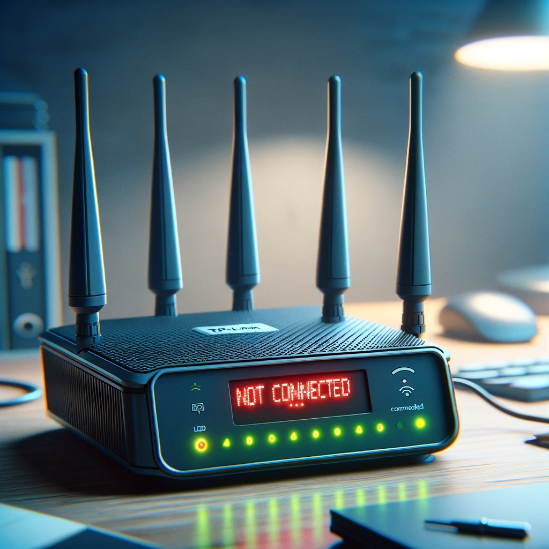
Common Challenges with TP-Link Routers:
TP-Link router users often face a spectrum of common problems, ranging from simple connectivity issues to more complex network configuration challenges. Some of the most frequent issues include:
-
Wi-Fi Connectivity Problems:
Situations where the TP-Link router is not connecting to the internet, leading to frustrating experiences of no internet access despite a seemingly active network.
-
Device-Specific Issues:
Certain challenges are unique to specific TP-Link models, such as difficulty in setting up or syncing devices like extenders or mesh systems.
-
Intermittent Connection:
This includes scenarios where the Wi-Fi signal fluctuates, causing inconsistent internet speed and stability.
-
Firmware and Software Glitches:
Outdated firmware or software issues can lead to problems like TP-Link routers not working properly.
Resolving General Connectivity Issues – TP-Link Not Connected to Internet
One of the most common issues faced by TP-Link users is the dreaded TP-Link not connected to internet scenario. This problem, often manifesting as TP-Link no internet or TP-Link Wi-Fi not working, can be caused by various factors, from simple cable misconnections to more complex network configuration errors. Let’s dive into a step-by-step guide to diagnose and fix these general connectivity issues.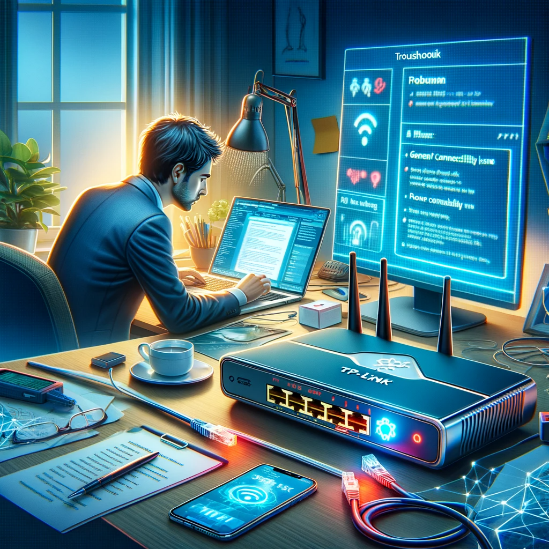
Step 1: Check Cable Connections
-
Physical Inspection:
Start by checking all wired connections. Ensure that the Ethernet cables are securely plugged in and undamaged. A loose or damaged cable can often be the root cause of TP-Link routers not connecting to the internet.
-
Router-Modem Connection:
Verify that the connection between your TP-Link router and the modem is intact. This is crucial for ensuring a stable internet connection.
Step 2: Restart Your TP-Link Device
-
Power Cycling:
Sometimes, the simplest solution to the TP-Link not connected to internet problem is restarting your device. Turn off your TP-Link router and modem, wait for a minute, and then turn them back on. This process, known as power cycling, can resolve temporary connectivity glitches.
-
Reset Button:
If the issue persists, consider using the reset button on your TP-Link device. However, be cautious, as this will revert the router to its factory settings.
Step 3: Check Basic Router Settings
-
Access Router Interface:
Use a web browser to log into your TP-Link router’s web interface. This is typically done by entering the router’s IP address (like 192.168.1.1) into the browser.
-
Network Settings:
Inside the router settings, verify that your WAN (Wide Area Network) settings are correctly configured. Incorrect WAN settings can lead to a TP-Link no internet issue.
-
Firmware Update:
Outdated firmware can cause TP-Link Wi-Fi not working problems. Check for firmware updates and install them if available.
Step 4: Diagnose Network Issues
-
Ping Test:
Conduct a ping test from your computer to diagnose network connectivity. Open the command prompt or terminal and type ping [website] (e.g., ping google.com). If the ping fails, it indicates a connectivity problem.
-
ISP Check:
Sometimes the issue might be on the ISP’s end. Contact your Internet Service Provider to ensure there are no outages or issues on their side that could be causing the TP-Link not connected to internet problem.
Step 5: Consult TP-Link Support
- If all else fails, reaching out to TP-Link’s customer support can provide further assistance. They can offer advanced troubleshooting steps specific to your TP-Link model.
Resolving the TP-Link not connected to internet issue can range from simple cable checks to more in-depth router setting adjustments. By systematically following these steps, you can diagnose and potentially fix the TP-Link no internet or TP-Link Wi-Fi not working problems, restoring your internet connectivity. Remember, consistent firmware updates and regular checks of your network settings can prevent many of these issues from arising in the first place.
TP-Link Router Problems and Issues
Encountering problems with your TP-Link router can be daunting. The troubleshoot TP-Link router process involves understanding various aspects of your device and the network. This section is dedicated to addressing common TP-Link router problems and TP-Link router issues with specific troubleshooting steps for different TP-Link devices including routers, extenders, Deco systems, and Kasa devices.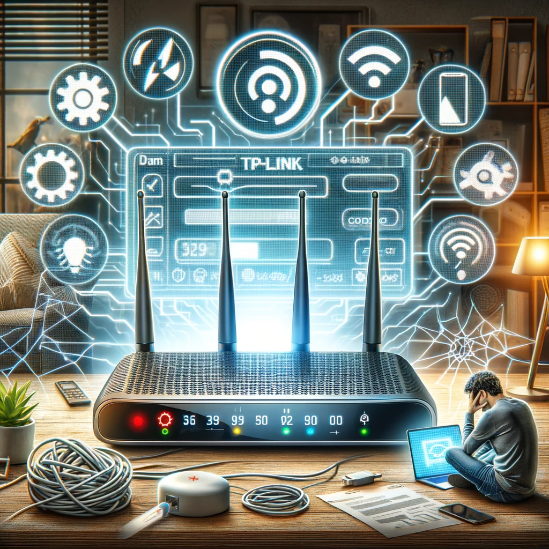
1: TP-Link Routers
-
Initial Checks:
Ensure your TP-Link router is powered on and the LED indicators are functioning correctly. A non-functioning LED could indicate a hardware problem.
-
Firmware Updates:
Outdated firmware can lead to various TP-Link router problems. Check for the latest firmware updates through the TP-Link admin interface.
-
Resetting the Router:
If you’re experiencing persistent TP-Link router issues, consider a factory reset. Remember, this will erase all your current settings.
2: TP-Link Extenders
-
Placement and Power:
Ensure your TP-Link extender is placed within a good range of your router and is receiving power.
-
Re-syncing:
If your extender is not communicating with the router, try re-syncing it. This often resolves connectivity issues.
-
Reset and Reconfigure:
In case of persistent problems, reset the extender and go through the setup process again.
3: TP-Link Deco Mesh Systems
-
Network Topology:
For TP-Link Deco issues, check your network topology. Ensure your Deco units are placed strategically to cover your area effectively.
-
Firmware Checks:
Similar to routers, keeping your Deco firmware up-to-date is vital in troubleshooting various issues.
-
Deco App:
Use the Deco app for diagnostics and to ensure all units are online and functioning correctly.
4: TP-Link Kasa Smart Devices
-
Wi-Fi Connectivity:
For Kasa devices, ensure they are within range of your Wi-Fi network. Poor signal strength can lead to connectivity issues.
-
Kasa App Configuration:
Use the Kasa app to check each device’s status and reconfigure them if necessary.
-
Compatibility Check:
Ensure your Kasa devices are compatible with your router’s frequency band. Some Kasa devices only support 2.4 GHz.
Troubleshooting your TP-Link router and associated devices doesn’t have to be a complex task. By following these specific steps, you can address and resolve many common TP-Link router problems and TP-Link router issues. Remember, regular maintenance, such as firmware updates and checking device configurations, can preempt many of these problems. If the issue persists, don’t hesitate to reach out to TP-Link’s customer support for professional assistance.
Resolving TP-Link Connected Without Internet Issues
A common and perplexing issue for many TP-Link users is when their device indicates it’s connected to the network, yet there’s no internet access. This section delves into the TP-Link connected without internet problem, which often manifests as TP-Link router connected but no internet or TP-Link Wi-Fi extender connected but no internet.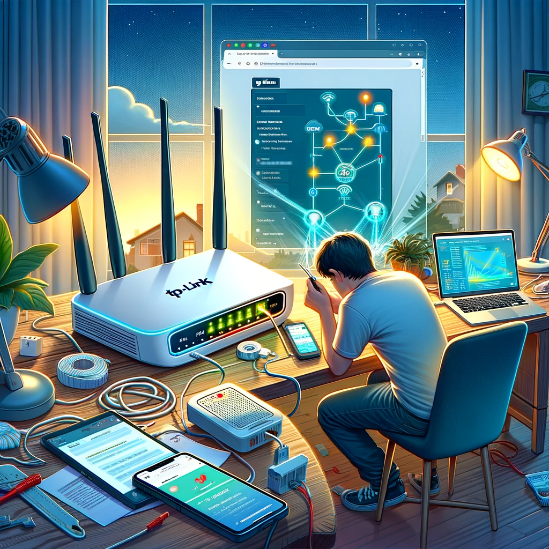
Understanding the Issue
- This problem typically occurs when your TP-Link device successfully connects to the local network but cannot access the internet. This can be due to various reasons, ranging from ISP issues to incorrect network settings.
Addressing DNS Settings
-
Changing DNS Servers:
A common fix for the TP-Link connected without internet issue involves changing the DNS settings on your TP-Link router. You can switch to public DNS servers like Google DNS (8.8.8.8 and 8.8.4.4) or OpenDNS.
-
DNS Configuration:
Access your TP-Link router’s settings and navigate to the DNS section to make this change. This might resolve the no internet issue if it’s related to DNS problems.
Checking Firmware Updates
-
Updating Firmware:
Outdated firmware can lead to a range of issues, including TP-Link router connected but no internet. Regularly check for and install firmware updates for your TP-Link devices.
-
Firmware Installation:
Access the router’s admin panel to update the firmware. Ensure you download the correct version for your specific TP-Link model to avoid further complications.
ISP-Related Problems
-
Internet Service Provider (ISP) Issues:
Sometimes, the TP-Link Wi-Fi extender connected but no internet problem is due to issues with your ISP. This could be a service outage or a problem specific to your connection.
-
Contacting ISP:
If you suspect an ISP issue, contact them for assistance. They can confirm if there are any known issues or outages in your area.
Router and Extender Specific Solutions
-
Router Reboot:
A simple yet effective step for routers showing connected but no internet is to reboot them. This can refresh your network connection.
-
Extender Reconfiguration:
For extenders, reconfigure the connection to the router. Sometimes, the extender might connect to the router but fail to facilitate an internet connection due to configuration errors.
The TP-Link connected without internet issue, often experienced as TP-Link router connected but no internet or TP-Link Wi-Fi extender connected but no internet, can be frustrating. However, by methodically checking DNS settings, ensuring firmware is up-to-date, and liaising with your ISP, you can often resolve these problems. Remember, each TP-Link device might require a slightly different approach, so tailor your troubleshooting steps accordingly. If these steps don’t yield results, TP-Link’s customer support is a valuable resource for resolving complex connectivity issues.
Troubleshooting Deco Mesh and Kasa Smart Devices
In this section, we focus on addressing the unique challenges faced by users of TP-Link’s Deco Mesh systems and Kasa smart home devices. Common issues like Deco not connecting to internet and Kasa plug not connecting, including concerns such as Deco mesh Wi-Fi not working and TP-Link smart plug not connecting, can often be resolved with targeted troubleshooting.
Deco Mesh Systems: Resolving Internet Connectivity Issues
-
Network Configuration:
For Deco not connecting to internet issues, check your Deco system’s network configuration. Ensure that the main Deco unit is properly connected to your modem and that the satellite units are in optimal locations for network coverage.
-
Firmware Updates:
Regularly updating the firmware of your Deco units can resolve a multitude of issues, including Deco mesh Wi-Fi not working. Updates often include fixes for connectivity and performance problems.
-
Deco App Diagnostics:
Use the Deco app to run network diagnostics. The app can help identify and guide you through resolving connectivity issues with your Deco system.
Kasa Smart Home Devices: Ensuring Seamless Connection
-
Wi-Fi Compatibility:
For Kasa plug not connecting issues, verify that your Wi-Fi network is compatible with the Kasa device. Most Kasa devices require a 2.4 GHz Wi-Fi network.
-
Signal Strength:
Weak Wi-Fi signals can lead to TP-Link smart plug not connecting problems. Ensure your Kasa devices are within a good range of your Wi-Fi router.
-
Kasa App Configuration:
Use the Kasa app for setting up and troubleshooting your smart devices. The app provides easy-to-follow steps for resolving connectivity issues.
Mesh Network Optimization
-
Placement of Deco Units:
Optimal placement of Deco units is crucial. Avoid physical obstructions and place the units strategically to enhance the mesh network’s effectiveness.
-
Network Testing:
Regularly test your network speed and coverage. This can help identify Deco not connecting to internet problems caused by poor mesh network layout.
Smart Device Integration
-
Device Compatibility:
Ensure that all your smart devices are compatible with each other. Incompatibility can lead to issues like Kasa plug not connecting.
-
Firmware and Software Updates:
Keep your Kasa devices and any related apps or software up-to-date to ensure smooth operation and integration.
Dealing with Deco not connecting to internet or Kasa plug not connecting issues can be straightforward with the right approach. By focusing on network optimization for your Deco Mesh system and ensuring proper setup and placement for your Kasa smart devices, many connectivity issues can be resolved. Regular updates and using the respective apps for diagnostics and configuration are key steps in maintaining a stable and efficient smart home network. If you continue to face challenges, TP-Link support is a valuable resource for additional troubleshooting and advice.
Solving Connectivity Issues with TP-Link Extenders
TP-Link extenders are essential for boosting Wi-Fi coverage, but they can sometimes present challenges like TP-Link extender not connected to internet, TP-Link Wi-Fi extender not working, or TP-Link extender connected but no internet. This section will guide you through resolving these common extender issues.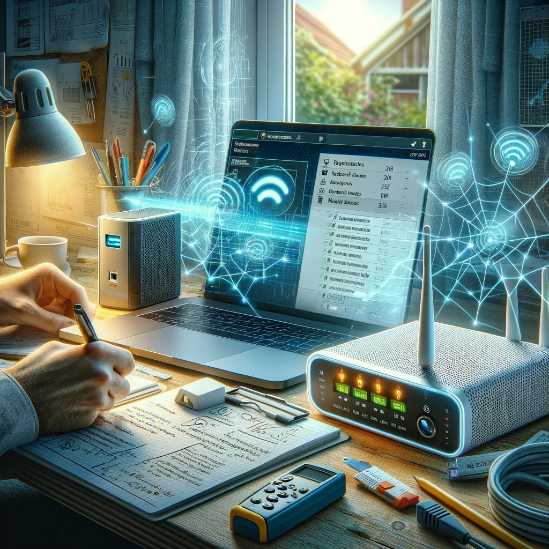
Understanding Extender Issues
- Extender problems often boil down to issues with placement, configuration, and communication with the main router. These can lead to situations where the extender appears to be working but fails to provide internet access.
Optimal Placement of Extenders
-
Strategic Positioning:
Place your TP-Link extender halfway between your router and the area with weak Wi-Fi. Avoid placing it near metal objects, microwaves, or thick walls, as these can interfere with the signal.
-
Signal Strength:
Ensure the extender is within a good signal range of the router. If it’s too far, it may not effectively extend the Wi-Fi, leading to TP-Link Wi-Fi extender not working issues.
Configuring Your TP-Link Extender
-
Proper Setup:
Follow the setup instructions carefully. Incorrect setup can lead to TP-Link extender not connected to internet.
-
Firmware Update:
Like routers, extenders also need regular firmware updates. An outdated firmware can cause connectivity problems, including the TP-Link extender connected but no internet issue.
Syncing with the Main Router
-
Seamless Integration:
Ensure your extender is properly synced with your main router. This involves checking if the extender is on the same network and using the correct Wi-Fi credentials.
-
Re-syncing Process:
If you’ve changed your router settings or Wi-Fi password, you’ll need to re-sync the extender to reflect these changes.
Advanced Troubleshooting Techniques
-
Factory Reset:
As a last resort, perform a factory reset on your extender. This will erase all settings, allowing you to set it up afresh, which can solve persistent issues.
-
Checking Connected Devices:
Sometimes, the issue might be with the device trying to connect to the extender. Ensure your device’s Wi-Fi settings are correctly configured to connect to the extender’s network.
Dealing with a TP-Link extender not connected to internet can be frustrating. However, by carefully considering the extender’s placement, ensuring proper configuration and syncing with your main router, and keeping the firmware up-to-date, you can significantly reduce the likelihood of facing TP-Link Wi-Fi extender not working or TP-Link extender connected but no internet problems. Remember, each step is crucial in creating a stable and extended Wi-Fi network in your home or office.
Advanced Troubleshooting for TP-Link Routers – TP-Link Router Problem
In this section, we explore advanced troubleshooting techniques for resolving intricate TP-Link router problems. Whether you’re grappling with TP-Link router won’t connect to internet or TP-Link not connecting to Wi-Fi, these advanced methods can help restore your router’s functionality.
Diagnosing Complex Router Issues
- Complex router problems can be caused by a combination of factors, including firmware glitches, advanced network settings, and compatibility issues. Let’s dive into advanced solutions for these challenges.
Factory Reset
-
Last Resort:
When all else fails, a factory reset can often resolve persistent TP-Link router problems. This returns your router to its default settings, eliminating any configuration issues.
-
Caution:
Be cautious when performing a factory reset, as it erases all settings, including custom configurations. Ensure you have backup copies of important settings before proceeding.
Manual Firmware Updates
-
Downloading Firmware:
In cases of TP-Link router won’t connect to internet due to outdated firmware, you can manually download and install the latest firmware from the TP-Link website.
-
Precise Installation:
Follow the manufacturer’s instructions carefully to ensure a successful firmware update. Incorrect installation can lead to further problems.
Advanced Network Settings
-
Port Forwarding:
If you encounter issues related to specific applications or services, configuring port forwarding in your router’s settings can resolve them.
-
Quality of Service (QoS):
QoS settings allow you to prioritize certain types of traffic, improving network performance for critical applications.
Expert Technical Support
-
Contacting TP-Link Support:
When faced with complex router problems that cannot be resolved through self-troubleshooting, don’t hesitate to reach out to TP-Link’s technical support team.
-
Professional Guidance:
TP-Link’s experts can provide specialized guidance and solutions tailored to your specific router model and issue.
Addressing TP-Link router problems that result in issues like TP-Link router won’t connect to internet or TP-Link not connecting to Wi-Fi often requires advanced troubleshooting techniques. By considering factory resets, manual firmware updates, and advanced network settings like port forwarding and QoS, you can tackle even the most intricate router issues. Remember, if you’re unsure about these procedures, seek professional guidance from TP-Link’s technical support team, ensuring a successful resolution to your router issues.
FAQS:
Q1: Why is my TP-Link router not connected to the internet?
- A1: If your TP-Link router is not connected to the internet, it could be due to various issues. First, check your router’s settings and make sure it’s properly configured to connect to your ISP. Ensure there are no physical cable issues and consider updating the router’s firmware.
Q2: What should I do if my TP-Link extender is not connected to the internet?
- A2: If your TP-Link extender is not connected to the internet, try re-syncing it with your main router. Ensure it’s placed within range and that you have a stable Wi-Fi connection. You can also check for firmware updates for the extender.
Q3: How can I fix the issue of TP-Link Wi-Fi extender not working?
- A3: If your TP-Link Wi-Fi extender is not working, start by verifying its placement within your network range. Check the extender’s configuration and ensure it’s synced with your main router. Firmware updates can often resolve this issue.
Q4: What should I do when my TP-Link Deco is not connecting to the internet?
- A4: When your TP-Link Deco is not connecting to the internet, ensure that the main Deco unit is properly connected to your modem. Check for firmware updates and use the Deco app for diagnostics.
Q5: How can I resolve the problem of TP-Link Kasa plug not connecting?
- A5: If your TP-Link Kasa plug is not connecting, ensure it’s within the range of your Wi-Fi network. Use the Kasa app for setup and configuration. Verify compatibility with your router’s frequency band.
Q6: Why is my Deco mesh Wi-Fi not working properly?
- A6: If your Deco mesh Wi-Fi is not working properly, check the placement of your Deco units for optimal coverage. Ensure all Deco units are online and consider firmware updates for improved performance.
Q7: What can I do if my TP-Link router is connected but there’s no internet access?
- A7: If your TP-Link router is connected but there’s no internet access, try changing DNS settings, updating firmware, and contacting your ISP to ensure there are no service outages.
Q8: How do I troubleshoot TP-Link router issues related to advanced network settings?
- A8: Troubleshooting TP-Link router issues involving advanced network settings like port forwarding and QoS requires accessing your router’s admin interface. Ensure you follow the manufacturer’s instructions and consider contacting TP-Link support for assistance.
Q9: Can a factory reset solve my TP-Link extender problems?
- A9: Yes, a factory reset can often resolve TP-Link extender problems. However, be cautious as it erases all settings. Backup important configurations before performing a factory reset.
Q10: How can I manually update the firmware of my TP-Link router?
- A10: To manually update the firmware of your TP-Link router, visit the TP-Link website, download the latest firmware for your router model, and follow the manufacturer’s instructions for installation.
Conclusion:
In conclusion, addressing common TP-Link router problems, TP-Link extender connectivity issues, and troubleshooting TP-Link Deco and Kasa smart devices can be a seamless process with the right knowledge and steps. Whether you’re dealing with TP-Link router won’t connect to internet, TP-Link extender not connected to internet, TP-Link Wi-Fi extender not working, or kasa plug not connecting, understanding the underlying causes and following the appropriate solutions is crucial.
By optimizing the placement of your TP-Link devices, keeping firmware up-to-date, and utilizing advanced techniques like factory resets and manual firmware updates, you can ensure a stable and reliable network connection. Additionally, don’t hesitate to seek expert assistance from TP-Link’s technical support when faced with complex issues related to TP-Link router problem or advanced network settings.
Incorporating these strategies will help you overcome challenges related to deco not connecting to internet, TP-Link router problem, TP-Link router connected but no internet, and TP-Link not connecting to Wi-Fi. Your network will be more resilient, ensuring that you can enjoy uninterrupted internet access and the seamless operation of your TP-Link devices.
Remember, maintaining the health of your TP-Link network involves regular monitoring, prompt updates, and strategic placement. By following these guidelines, you can create a robust and efficient network environment, making connectivity issues a thing of the past.
To know more about TP-Link router and resolve its related issues, Visit TP-Link Support page.

